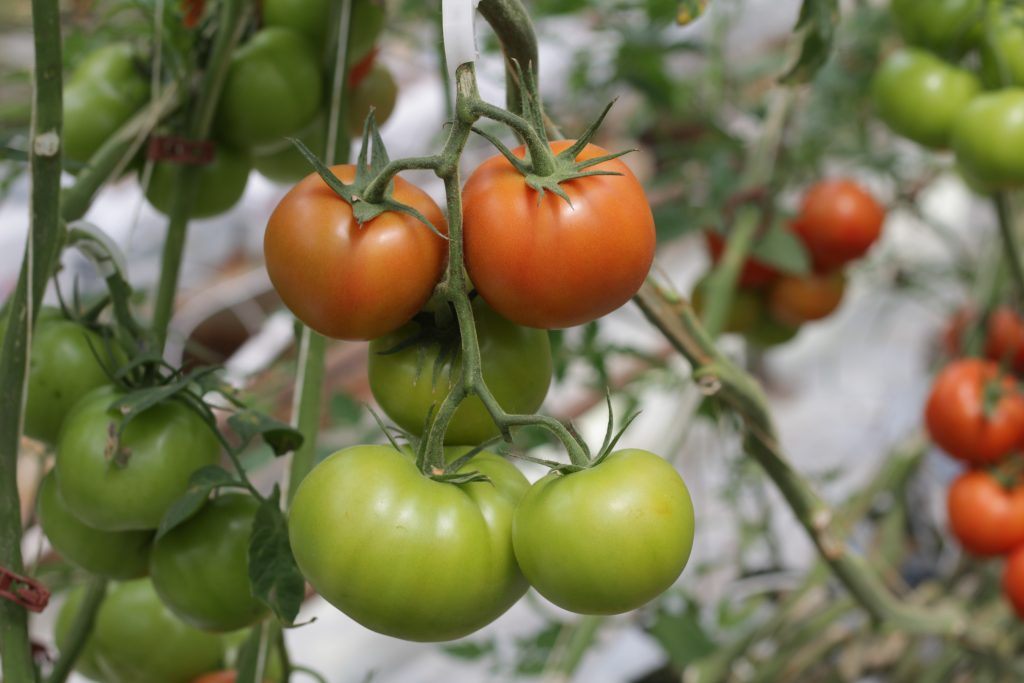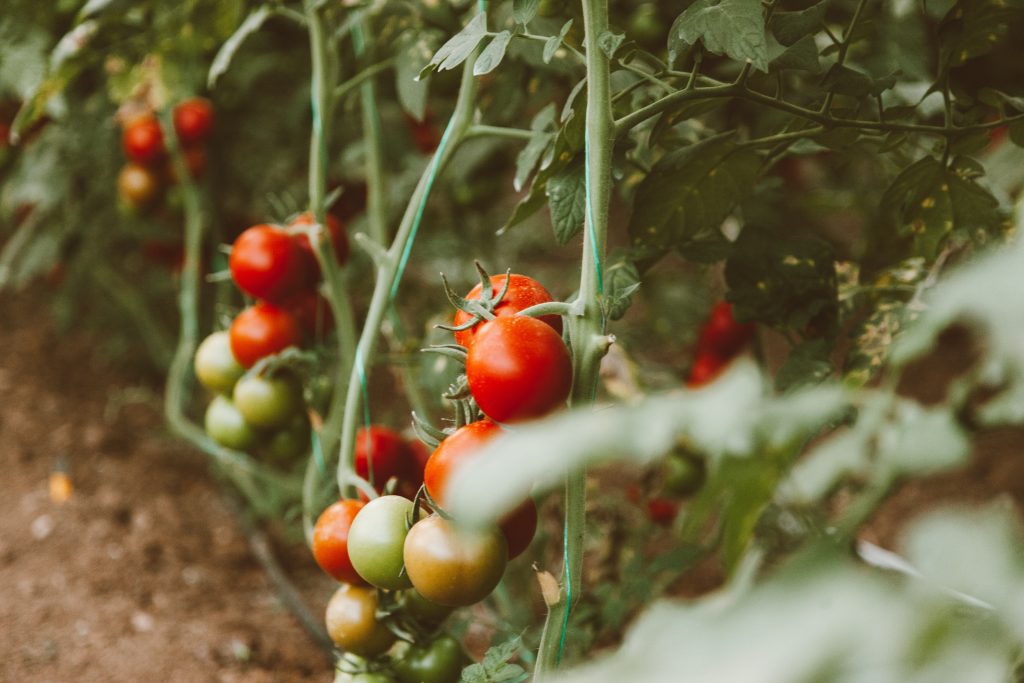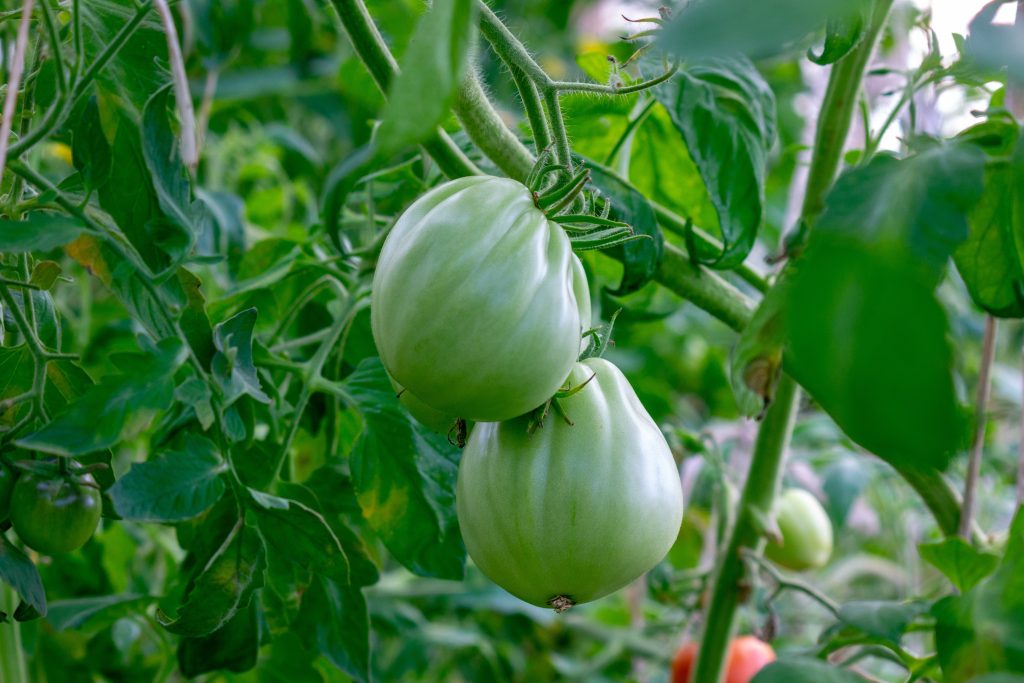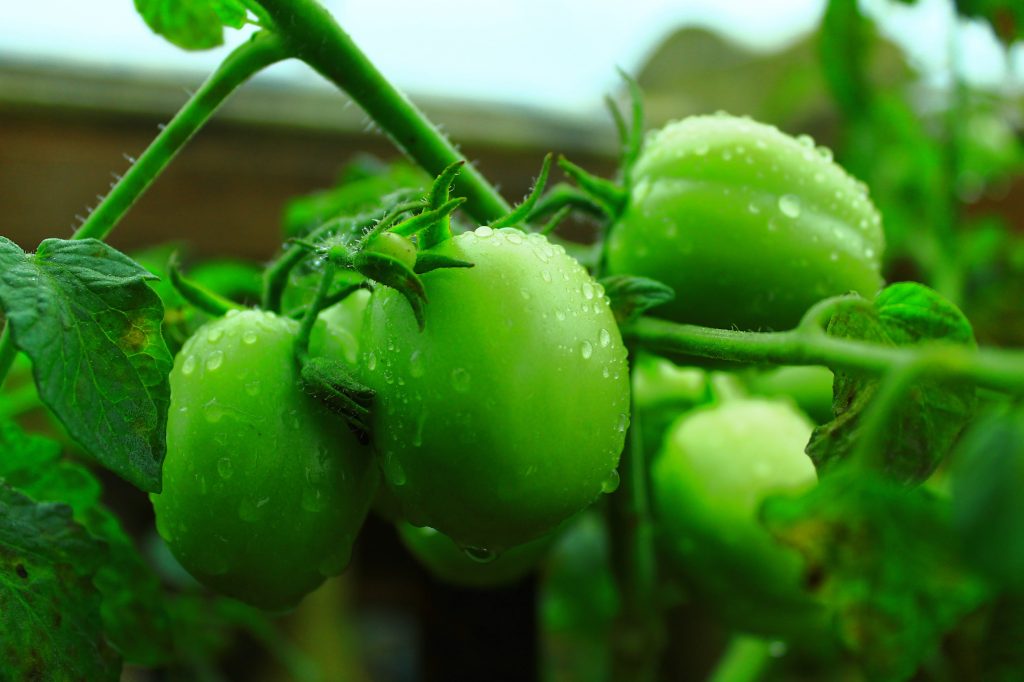Pruning boosts tomato plant productivity by directing the plant’s energy towards fruit production and improving air circulation, sunlight penetration, and overall plant health. By removing excess foliage, especially lower leaves and suckers (side shoots that develop in leaf axils), pruning reduces competition for nutrients and redirects resources to developing fruit. This focused energy allocation results in larger, more flavorful tomatoes and increases the overall yield per plant. Additionally, pruning opens up the plant canopy, allowing sunlight to reach lower leaves and fruit, which promotes photosynthesis and enhances fruit ripening. Improved air circulation around the plant helps prevent disease by reducing humidity and minimizing the risk of fungal infections. Overall, strategic pruning not only increases tomato plant productivity but also improves fruit quality and reduces the likelihood of pest and disease issues, resulting in a more bountiful and healthy harvest.
Pruning tomato plants is a common practice that can help increase yield, improve plant health, and promote better fruit quality. Here are the steps to prune tomato plants:
- Wait until the tomato plant has grown to about 12-18 inches tall and has developed at least two to three sets of leaves.
- Identify the “suckers,” which are small, new shoots that emerge from the joint between the stem and a branch or leaf. These suckers can divert energy away from the main stem and reduce fruit production.
- Use a pair of clean, sharp pruning shears or scissors to carefully remove the suckers. Cut them off at the base, as close to the main stem as possible. Be careful not to damage the main stem or other healthy branches.
4. Continue to monitor the tomato plant throughout the growing season and remove any additional suckers that appear.
5. Additionally, you can also prune off the lower leaves of the tomato plant that touch the ground, as these can be more susceptible to disease and pests. Remove any yellow or damaged leaves as well.
6. Finally, if your tomato plant is getting too tall and leggy, you can also trim the top few inches of the main stem to encourage bushier growth.
Remember to avoid pruning during wet weather or in the heat of the day, as this can increase the risk of disease and damage to the plant. Happy pruning!
There is a vast array of tomato varieties cultivated worldwide, each offering unique flavors, colors, sizes, and growth habits to suit diverse culinary preferences and growing conditions. Popular heirloom varieties like Brandywine, Cherokee Purple, and Green Zebra boast rich, complex flavors and vibrant colors, prized by gardeners and chefs alike for their culinary versatility and historical significance. Hybrid varieties such as Beefsteak, Roma, and Celebrity are renowned for their uniform size, disease resistance, and prolific yields, making them favored choices for commercial production and home gardening. Cherry and grape tomatoes, including Sweet 100, Sun Gold, and Sweet Million, offer small, sweet fruits ideal for snacking, salads, and fresh pasta sauces. Indeterminate varieties like San Marzano and Amish Paste are prized for their meaty texture and robust flavor, perfect for canning and sauce-making. With thousands of tomato cultivars available worldwide, ranging from tiny currant tomatoes to hefty beefsteaks, there is a tomato variety to suit every taste and culinary need, ensuring a diverse and flavorful selection for growers and consumers alike.

Why Pruning a Tomato Plant is very important?
Pruning tomato plants is important for several reasons:
- Improved air circulation: Pruning helps to increase air circulation around the plant, which can reduce the risk of fungal diseases and promote faster drying of foliage after rainfall or watering.
- Better sunlight penetration: Pruning allows more sunlight to reach the lower leaves and fruit on the plant, which can improve fruit production and ripening.
- Disease prevention: Removing infected or damaged leaves and branches can prevent the spread of disease throughout the plant.
- Increased fruit production: Pruning can redirect the plant’s energy into producing more fruit, rather than putting energy into growing excess foliage.
- Easier harvesting: Pruning can make it easier to see and access the ripe fruit on the plant, making harvesting quicker and more efficient.
It’s important to note that not all tomato plants need to be pruned. Determinate tomato varieties, for example, typically don’t require much pruning as they naturally grow to a certain size and produce fruit all at once. Indeterminate tomato varieties, on the other hand, can benefit greatly from pruning to promote healthy growth and abundant fruit production.

Does pruning tomatoes help ripen?
Pruning tomatoes can help ripen fruit by allowing more sunlight to reach the remaining fruit on the plant. When leaves and branches are removed, the remaining fruit is exposed to more sunlight, which helps to speed up the ripening process.
However, it’s important to note that pruning alone won’t necessarily result in faster ripening. Other factors, such as temperature, humidity, and the stage of growth the plant is in, also play a role in how quickly tomatoes ripen.
In addition to pruning, there are other techniques that can help ripen tomatoes more quickly, such as removing suckers, trimming back foliage, and reducing watering as the fruit begins to ripen. These techniques should be used in combination with pruning to encourage faster and more even ripening.

When should tomatoes be pruned?
Tomatoes should be pruned regularly throughout the growing season to maintain plant health and promote fruit production. Here are some general guidelines for when to prune tomatoes:
- Early pruning: When the plant is young and just starting to grow, it’s a good idea to remove any suckers that appear at the base of the plant. This will encourage the plant to put its energy into growing a strong main stem and root system.
- Mid-season pruning: As the plant grows taller, continue to remove any suckers that appear at the base of the plant. You can also remove any branches or leaves that are touching the ground or are diseased or damaged.
- Late-season pruning: In the weeks leading up to the first frost, it’s a good idea to remove any flowers or fruit that are unlikely to ripen before the end of the season. This will encourage the plant to put its energy into ripening the remaining fruit.
When pruning tomatoes, it’s important to use clean, sharp pruning shears to prevent the spread of disease. You should also avoid pruning in the middle of the day when the sun is hottest, as this can stress the plant. Instead, prune early in the morning or in the late afternoon when temperatures are cooler.

What are the advantages and disadvantages of pruning tomatoes?
Pruning tomatoes can have both advantages and disadvantages. Here are some of the main ones:
Advantages:
- Increased fruit production: Pruning can redirect the plant’s energy into producing more fruit, rather than putting energy into growing excess foliage.
- Improved air circulation: Pruning helps to increase air circulation around the plant, which can reduce the risk of fungal diseases and promote faster drying of foliage after rainfall or watering.
- Better sunlight penetration: Pruning allows more sunlight to reach the lower leaves and fruit on the plant, which can improve fruit production and ripening.
- Easier harvesting: Pruning can make it easier to see and access the ripe fruit on the plant, making harvesting quicker and more efficient.
Disadvantages:
- Increased risk of sunscald: If too much foliage is removed, the fruit on the plant may be exposed to too much direct sunlight, which can cause sunscald and damage the fruit.
- Increased risk of disease: If pruning is done improperly or with dirty tools, it can spread disease throughout the plant.
- Reduced plant size: Pruning can reduce the overall size of the plant, which may be a disadvantage if you’re looking for a large, bushy tomato plant.
- Increased maintenance: Pruning requires regular attention and maintenance, which may be a disadvantage if you’re looking for a low-maintenance plant.
Overall, the advantages of pruning tomato plants generally outweigh the disadvantages, especially if done correctly and carefully. However, it’s important to consider the specific needs of your tomato plants and to monitor them closely to ensure they are healthy and productive.
Growing tomatoes for business can be a lucrative venture if done efficiently and with careful planning. Here’s a general guide on how to grow tomatoes for commercial purposes:
- Market Research: Conduct thorough market research to identify demand for tomatoes in your area or target market. Consider factors like consumer preferences, local climate conditions, and competition from other growers.
- Site Selection: Choose a suitable location for your tomato farm with access to ample sunlight, well-drained soil, and reliable water sources. Consider factors like proximity to markets, transportation routes, and infrastructure for packaging and storage.
- Variety Selection: Select tomato varieties that are well-suited to your climate, market demand, and intended use (e.g., fresh market, processing, or specialty varieties). Consider factors like disease resistance, yield potential, and flavor profiles.
- Crop Planning and Management: Develop a comprehensive crop plan that outlines planting schedules, spacing, and cultivation practices. Implement best practices for soil preparation, irrigation, fertilization, and pest and disease management to optimize crop health and yield.
- Greenhouse or Open Field Production: Decide whether to grow tomatoes in open fields or controlled environments like greenhouses or high tunnels. Greenhouse production offers advantages like extended growing seasons, climate control, and protection from pests and diseases, but requires additional investment in infrastructure and management.
- Harvesting and Handling: Implement efficient harvesting techniques to minimize damage to fruits and maximize yield. Handle harvested tomatoes with care to prevent bruising and spoilage, and ensure proper storage conditions to maintain freshness and quality.
- Packaging and Marketing: Invest in attractive packaging and labeling to enhance product appeal and differentiate your tomatoes in the market. Develop marketing strategies to promote your tomatoes through farmers’ markets, direct sales to restaurants and retailers, or online platforms.
- Quality Control and Customer Service: Implement rigorous quality control measures throughout the production and distribution process to ensure consistent quality and customer satisfaction. Provide excellent customer service and address any feedback or concerns promptly to build trust and loyalty among buyers.
- Financial Management: Develop a comprehensive business plan that outlines your production costs, revenue projections, and profit margins. Monitor your expenses, revenues, and cash flow regularly to ensure profitability and sustainability.
By following these steps and adapting them to your specific circumstances, you can establish a successful tomato-growing business that meets market demand, generates revenue, and contributes to the local food economy.

